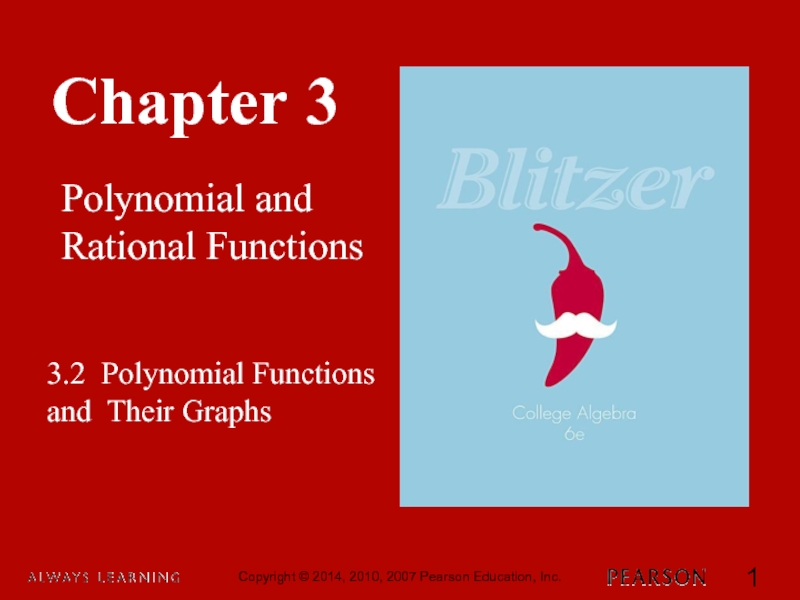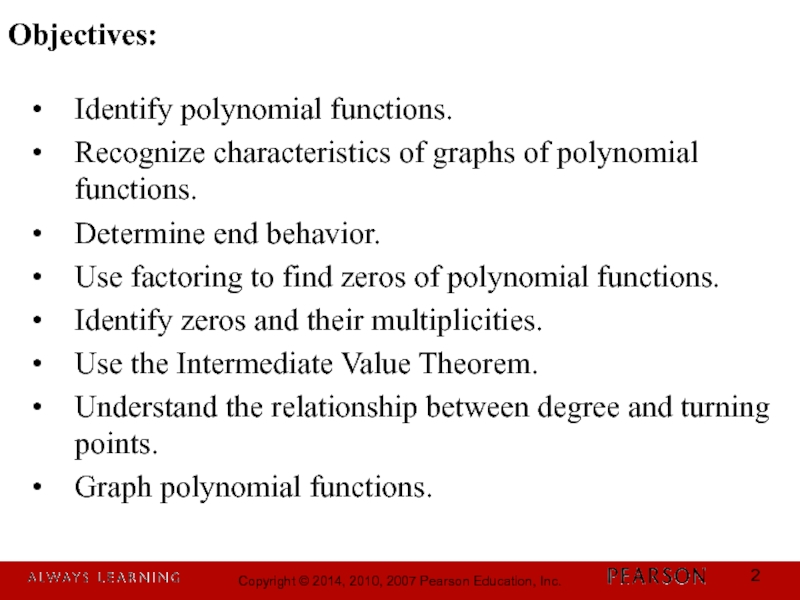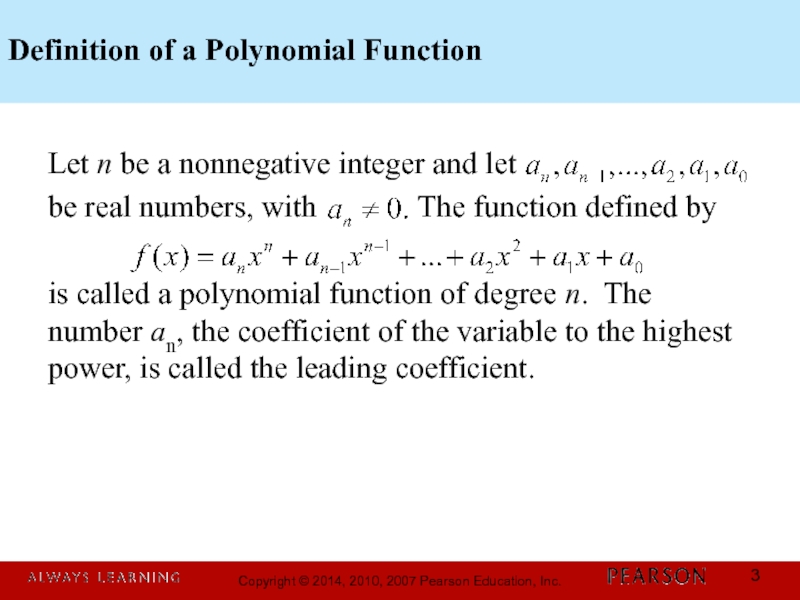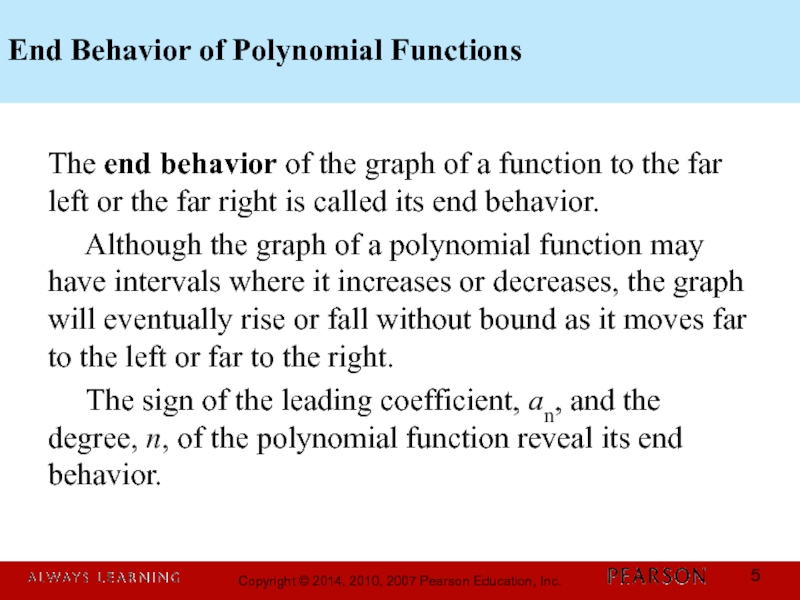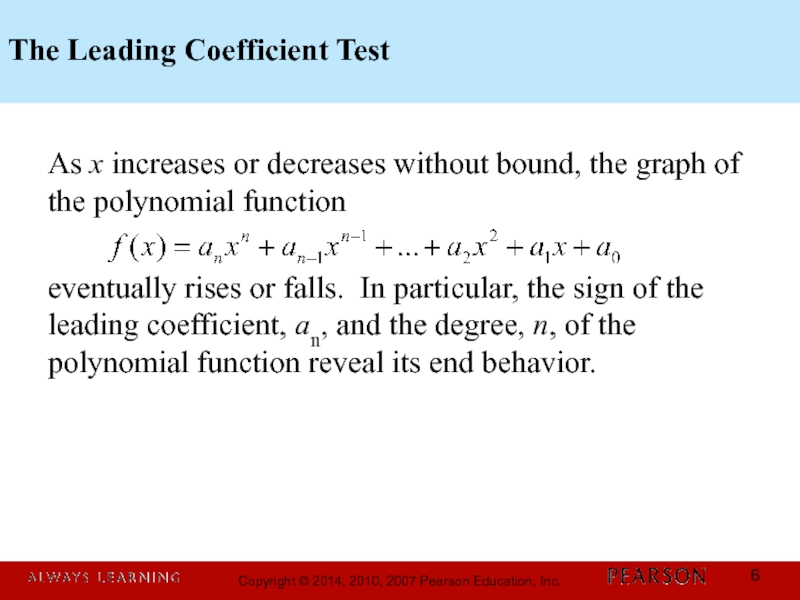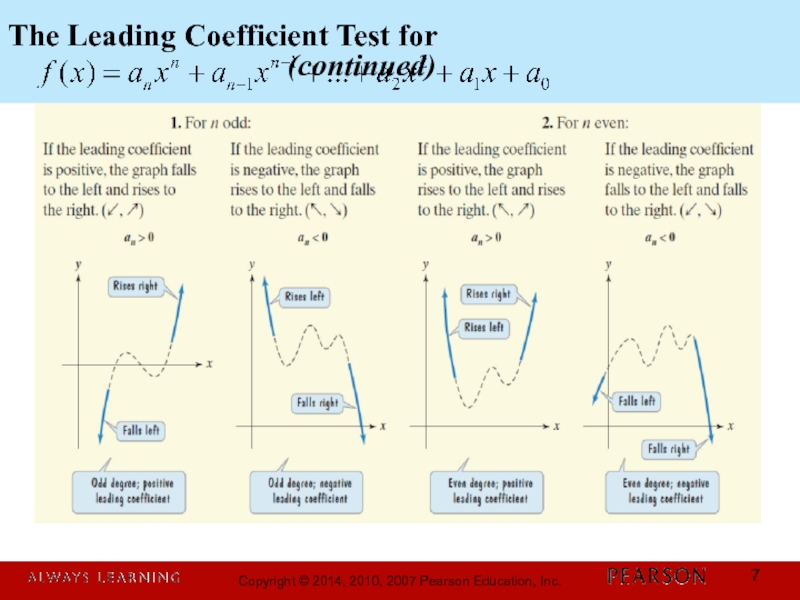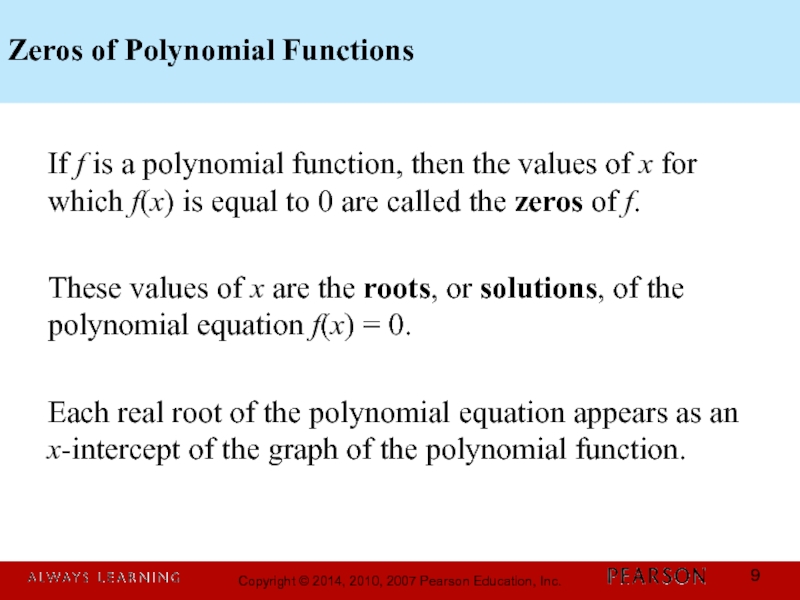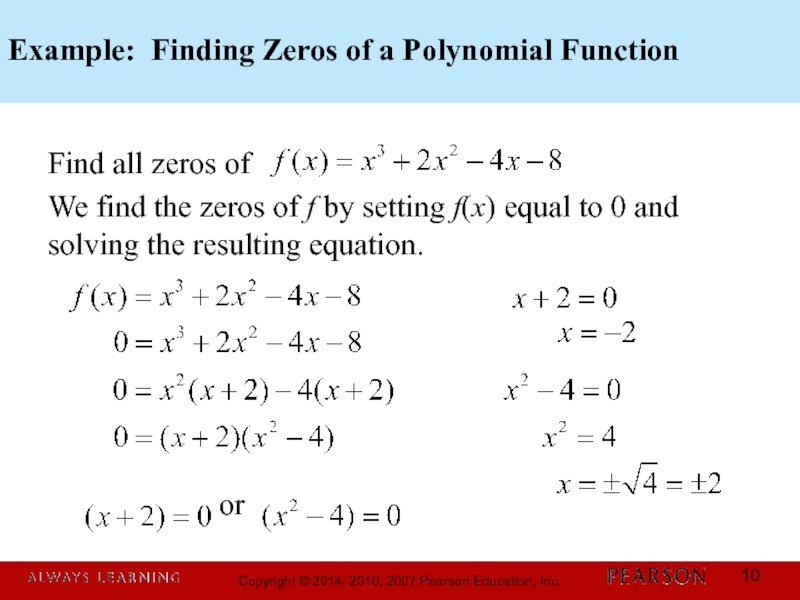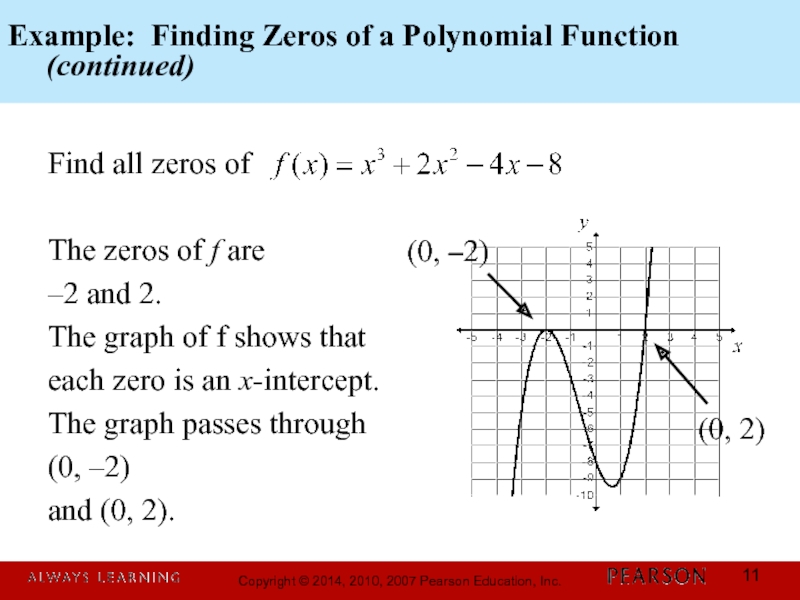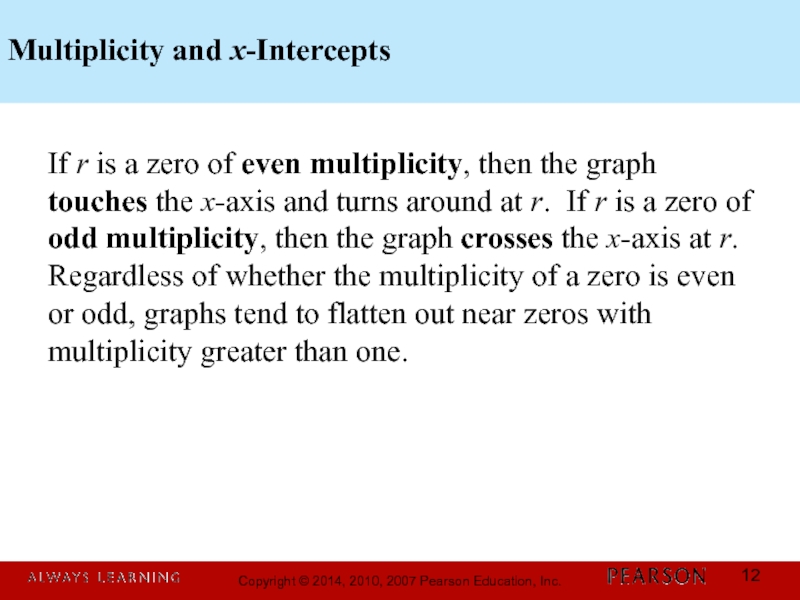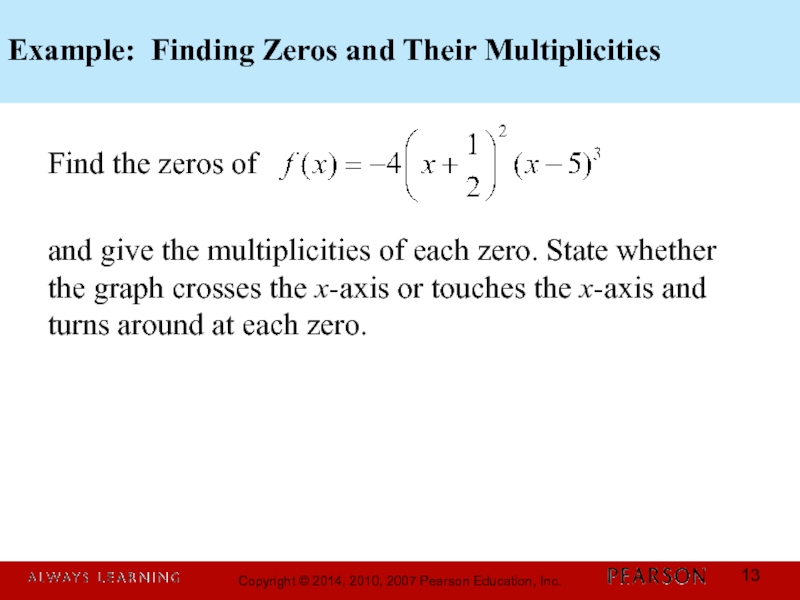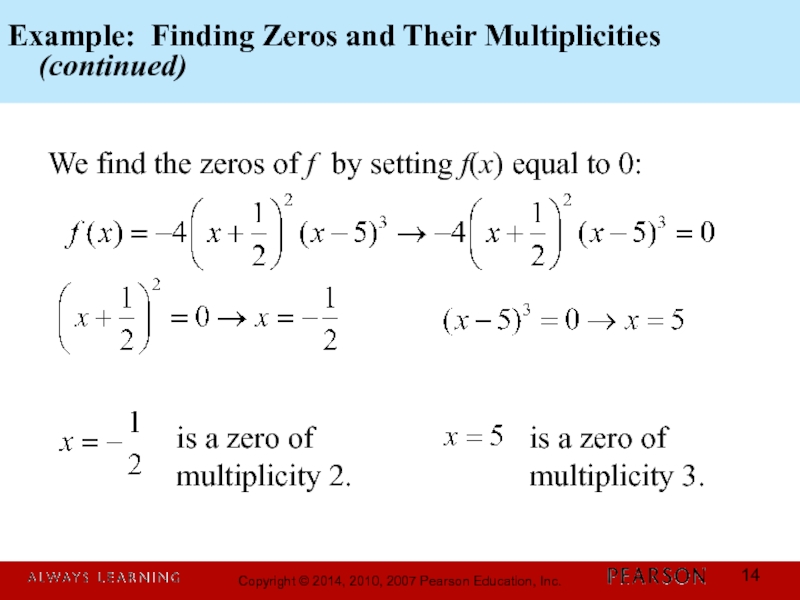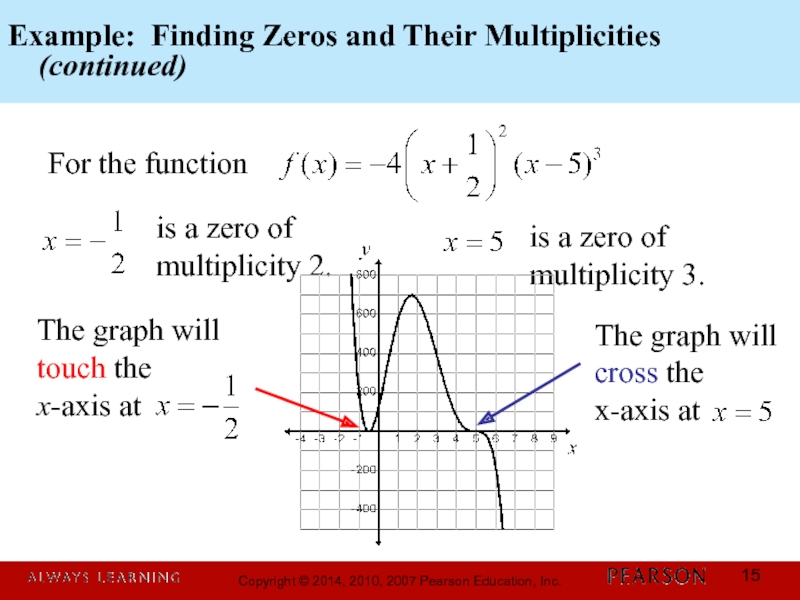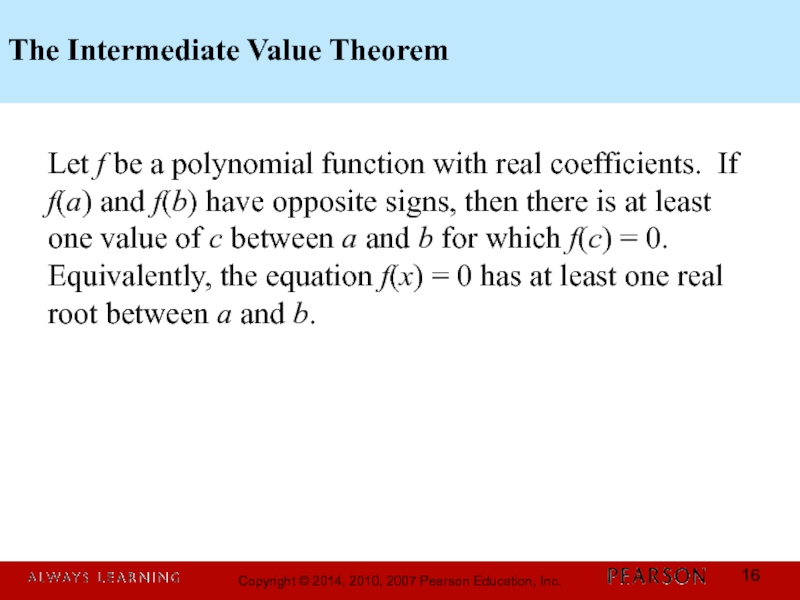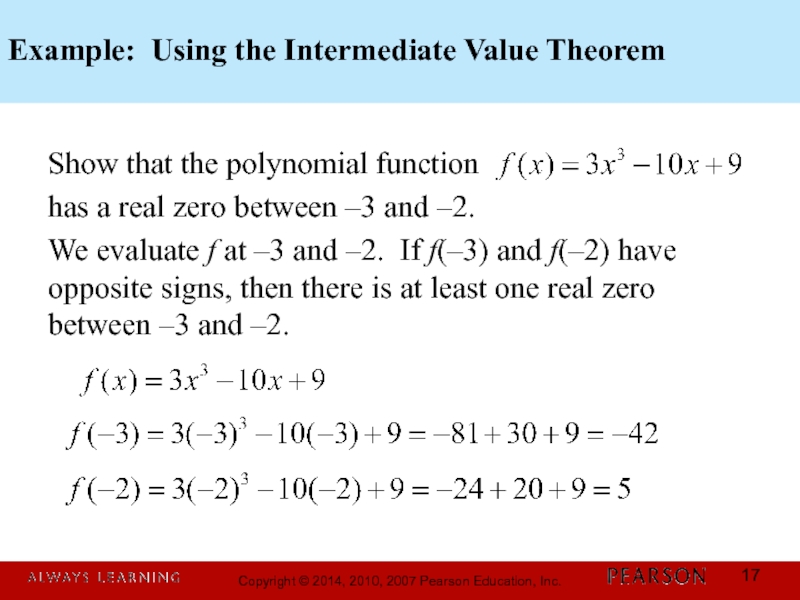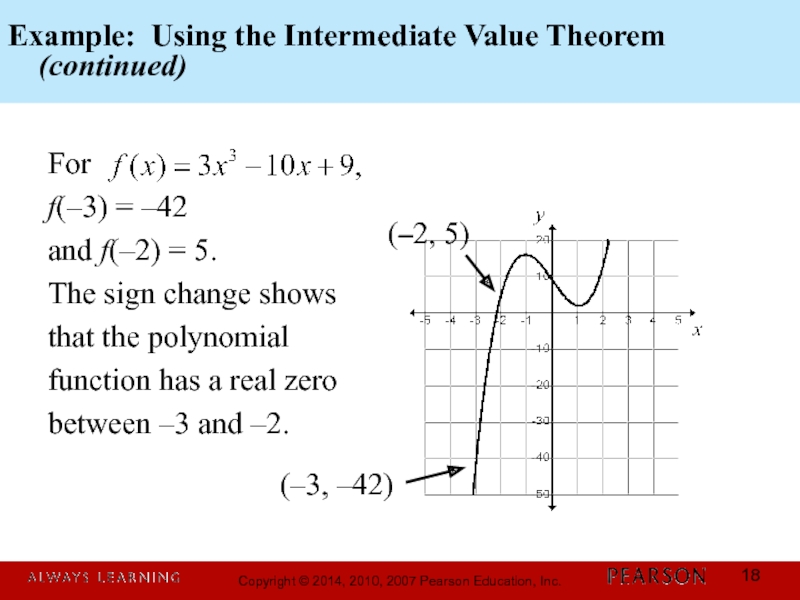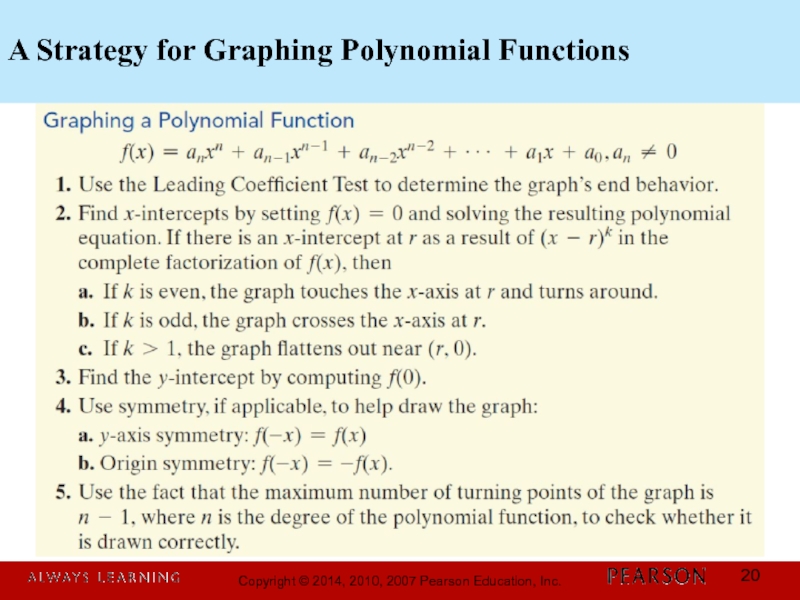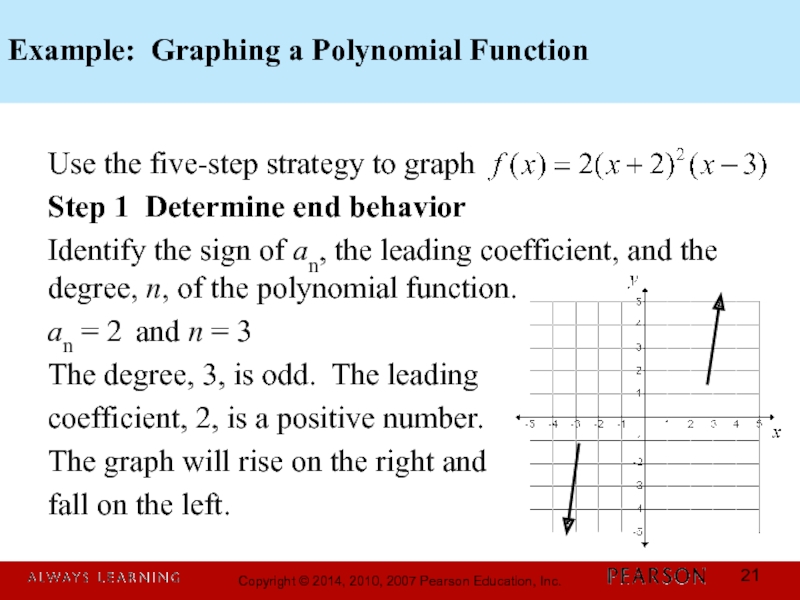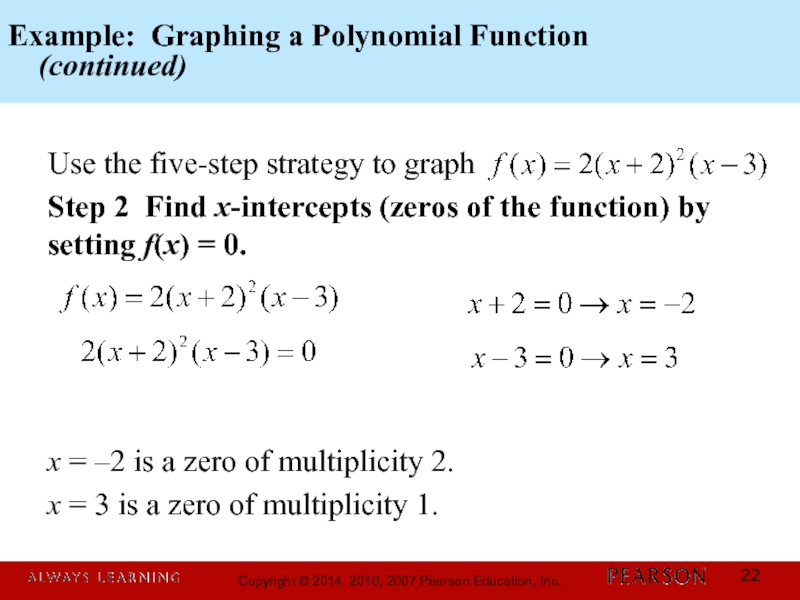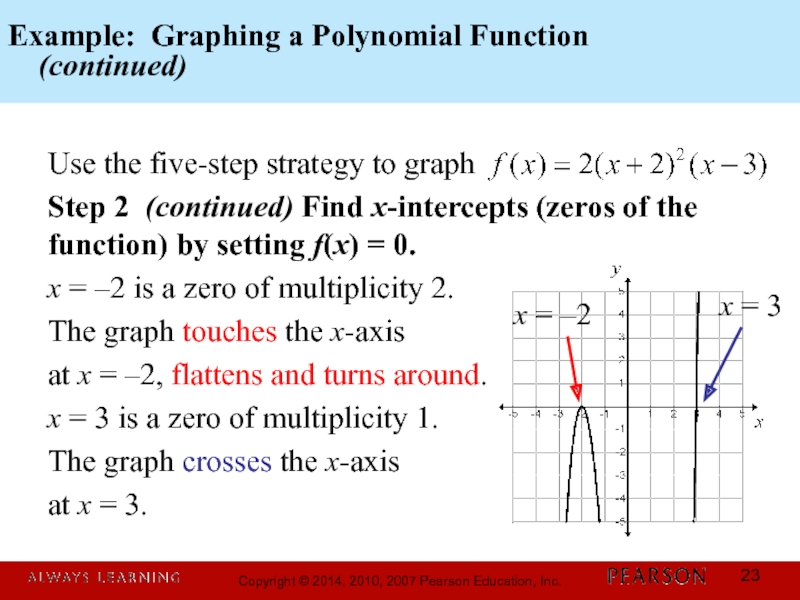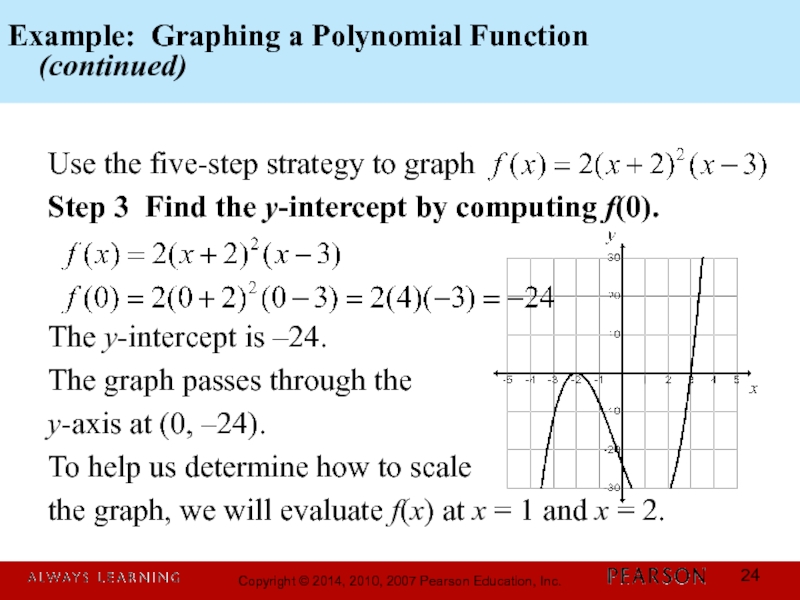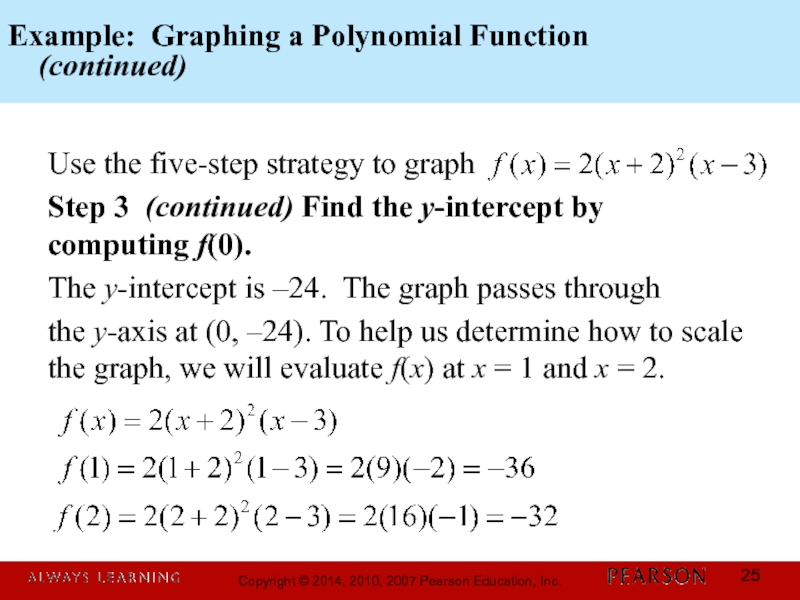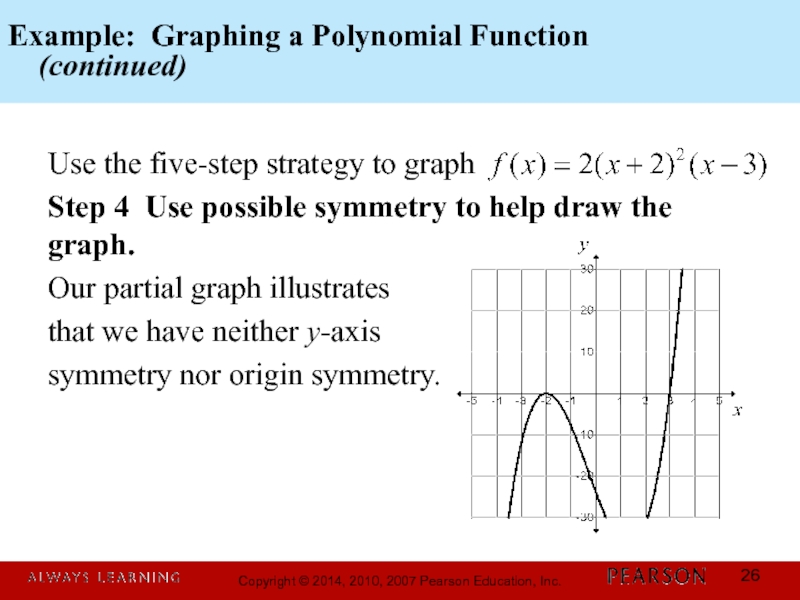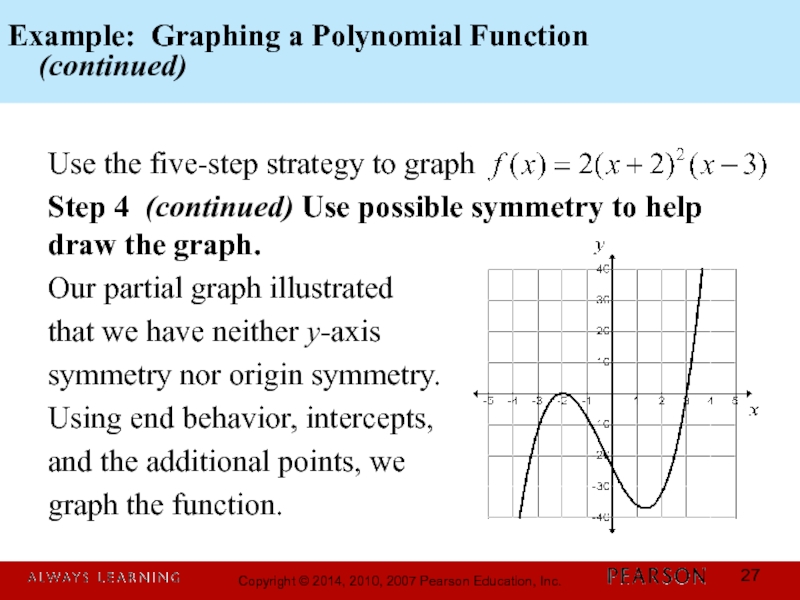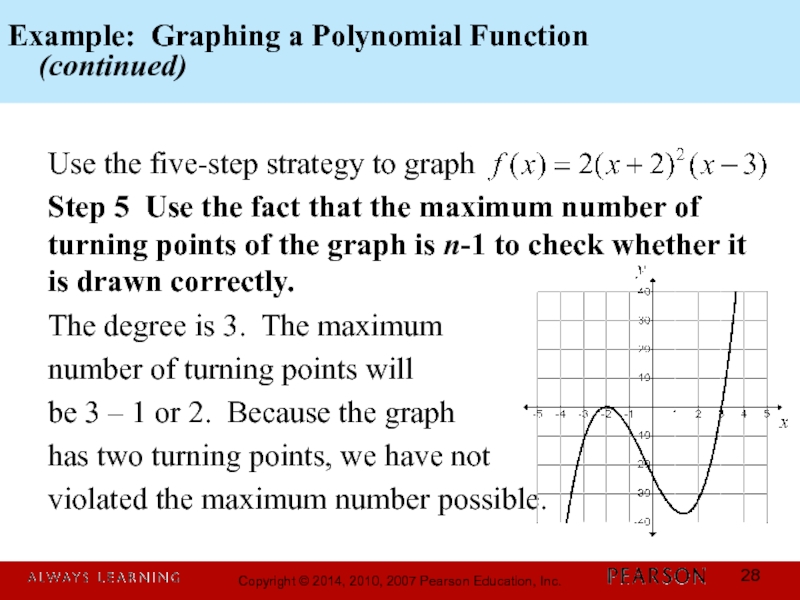3.2 Polynomial Functions
and Their Graphs
- Главная
- Разное
- Дизайн
- Бизнес и предпринимательство
- Аналитика
- Образование
- Развлечения
- Красота и здоровье
- Финансы
- Государство
- Путешествия
- Спорт
- Недвижимость
- Армия
- Графика
- Культурология
- Еда и кулинария
- Лингвистика
- Английский язык
- Астрономия
- Алгебра
- Биология
- География
- Детские презентации
- Информатика
- История
- Литература
- Маркетинг
- Математика
- Медицина
- Менеджмент
- Музыка
- МХК
- Немецкий язык
- ОБЖ
- Обществознание
- Окружающий мир
- Педагогика
- Русский язык
- Технология
- Физика
- Философия
- Химия
- Шаблоны, картинки для презентаций
- Экология
- Экономика
- Юриспруденция
Chapter 3. Polynomial and Rational Functions. 3.2 Polynomial Functions and Their Graphs презентация
Содержание
- 1. Chapter 3. Polynomial and Rational Functions. 3.2 Polynomial Functions and Their Graphs
- 2. Identify polynomial functions. Recognize characteristics of graphs
- 3. Definition of a Polynomial Function Let n
- 4. Graphs of Polynomial Functions – Smooth and
- 5. End Behavior of Polynomial Functions The end
- 6. The Leading Coefficient Test As x increases
- 7. The Leading Coefficient Test for (continued)
- 8. Example: Using the Leading Coefficient Test Use
- 9. Zeros of Polynomial Functions If f is
- 10. Example: Finding Zeros of a Polynomial Function
- 11. Example: Finding Zeros of a Polynomial Function
- 12. Multiplicity and x-Intercepts If r is a
- 13. Example: Finding Zeros and Their Multiplicities Find
- 14. Example: Finding Zeros and Their Multiplicities
- 15. Example: Finding Zeros and Their Multiplicities
- 16. The Intermediate Value Theorem Let f be
- 17. Example: Using the Intermediate Value Theorem Show
- 18. Example: Using the Intermediate Value Theorem
- 19. Turning Points of Polynomial Functions In general,
- 20. A Strategy for Graphing Polynomial Functions
- 21. Example: Graphing a Polynomial Function Use the
- 22. Example: Graphing a Polynomial Function
- 23. Example: Graphing a Polynomial Function
- 24. Example: Graphing a Polynomial Function
- 25. Example: Graphing a Polynomial Function
- 26. Example: Graphing a Polynomial Function
- 27. Example: Graphing a Polynomial Function
- 28. Example: Graphing a Polynomial Function
Слайд 1 Chapter 3
Polynomial and Rational Functions
Copyright © 2014, 2010, 2007 Pearson
Слайд 2Identify polynomial functions.
Recognize characteristics of graphs of polynomial functions.
Determine end behavior.
Use
Identify zeros and their multiplicities.
Use the Intermediate Value Theorem.
Understand the relationship between degree and turning points.
Graph polynomial functions.
Objectives:
Слайд 3Definition of a Polynomial Function
Let n be a nonnegative integer and
be real numbers, with The function defined by
is called a polynomial function of degree n. The number an, the coefficient of the variable to the highest power, is called the leading coefficient.
Слайд 4Graphs of Polynomial Functions – Smooth and Continuous
Polynomial functions of degree
By smooth, we mean that the graphs contain only rounded curves with no sharp corners.
By continuous, we mean that the graphs have no breaks and can be drawn without lifting your pencil from the rectangular coordinate system.
Слайд 5End Behavior of Polynomial Functions
The end behavior of the graph of
Although the graph of a polynomial function may have intervals where it increases or decreases, the graph will eventually rise or fall without bound as it moves far to the left or far to the right.
The sign of the leading coefficient, an, and the degree, n, of the polynomial function reveal its end behavior.
Слайд 6The Leading Coefficient Test
As x increases or decreases without bound, the
eventually rises or falls. In particular, the sign of the leading coefficient, an, and the degree, n, of the polynomial function reveal its end behavior.
Слайд 8Example: Using the Leading Coefficient Test
Use the Leading Coefficient Test to
The degree of the function is 4,
which is even. Even-degree
functions have graphs with the
same behavior at each end.
The leading coefficient, 1, is
positive. The graph rises to
the left and to the right.
Слайд 9Zeros of Polynomial Functions
If f is a polynomial function, then the
These values of x are the roots, or solutions, of the polynomial equation f(x) = 0.
Each real root of the polynomial equation appears as an x-intercept of the graph of the polynomial function.
Слайд 10Example: Finding Zeros of a Polynomial Function
Find all zeros of
We
or
Слайд 11Example: Finding Zeros of a Polynomial Function
(continued)
Find all
The zeros of f are
–2 and 2.
The graph of f shows that
each zero is an x-intercept.
The graph passes through
(0, –2)
and (0, 2).
(0, –2)
(0, 2)
Слайд 12Multiplicity and x-Intercepts
If r is a zero of even multiplicity, then
Слайд 13Example: Finding Zeros and Their Multiplicities
Find the zeros of
and give
Слайд 14Example: Finding Zeros and Their Multiplicities
(continued)
We find the zeros
is a zero of
multiplicity 2.
is a zero of
multiplicity 3.
Слайд 15Example: Finding Zeros and Their Multiplicities
(continued)
For the function
is
multiplicity 2.
is a zero of
multiplicity 3.
The graph will
touch the
x-axis at
The graph will
cross the
x-axis at
Слайд 16The Intermediate Value Theorem
Let f be a polynomial function with real
Слайд 17Example: Using the Intermediate Value Theorem
Show that the polynomial function
has a
We evaluate f at –3 and –2. If f(–3) and f(–2) have opposite signs, then there is at least one real zero between –3 and –2.
Слайд 18Example: Using the Intermediate Value Theorem
(continued)
For
f(–3) = –42
and f(–2) = 5.
The sign change shows
that the polynomial
function has a real zero
between –3 and –2.
(–2, 5)
(–3, –42)
Слайд 19Turning Points of Polynomial Functions
In general, if f is a polynomial
Слайд 21Example: Graphing a Polynomial Function
Use the five-step strategy to graph
Step 1
Identify the sign of an, the leading coefficient, and the degree, n, of the polynomial function.
an = 2 and n = 3
The degree, 3, is odd. The leading
coefficient, 2, is a positive number.
The graph will rise on the right and
fall on the left.
Слайд 22Example: Graphing a Polynomial Function
(continued)
Use the five-step strategy to
Step 2 Find x-intercepts (zeros of the function) by setting f(x) = 0.
x = –2 is a zero of multiplicity 2.
x = 3 is a zero of multiplicity 1.
Слайд 23Example: Graphing a Polynomial Function
(continued)
Use the five-step strategy to
Step 2 (continued) Find x-intercepts (zeros of the function) by setting f(x) = 0.
x = –2 is a zero of multiplicity 2.
The graph touches the x-axis
at x = –2, flattens and turns around.
x = 3 is a zero of multiplicity 1.
The graph crosses the x-axis
at x = 3.
x = –2
x = 3
Слайд 24Example: Graphing a Polynomial Function
(continued)
Use the five-step strategy to
Step 3 Find the y-intercept by computing f(0).
The y-intercept is –24.
The graph passes through the
y-axis at (0, –24).
To help us determine how to scale
the graph, we will evaluate f(x) at x = 1 and x = 2.
Слайд 25Example: Graphing a Polynomial Function
(continued)
Use the five-step strategy to
Step 3 (continued) Find the y-intercept by computing f(0).
The y-intercept is –24. The graph passes through
the y-axis at (0, –24). To help us determine how to scale the graph, we will evaluate f(x) at x = 1 and x = 2.
Слайд 26Example: Graphing a Polynomial Function
(continued)
Use the five-step strategy to
Step 4 Use possible symmetry to help draw the graph.
Our partial graph illustrates
that we have neither y-axis
symmetry nor origin symmetry.
Слайд 27Example: Graphing a Polynomial Function
(continued)
Use the five-step strategy to
Step 4 (continued) Use possible symmetry to help draw the graph.
Our partial graph illustrated
that we have neither y-axis
symmetry nor origin symmetry.
Using end behavior, intercepts,
and the additional points, we
graph the function.
Слайд 28Example: Graphing a Polynomial Function
(continued)
Use the five-step strategy to
Step 5 Use the fact that the maximum number of turning points of the graph is n-1 to check whether it is drawn correctly.
The degree is 3. The maximum
number of turning points will
be 3 – 1 or 2. Because the graph
has two turning points, we have not
violated the maximum number possible.
